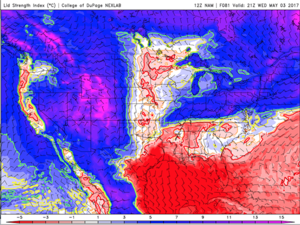Jeremy Perez
Supporter
If this is old news, please forgive some excitement.
I just noticed Lid Strength Index was included on College of DuPage convective products for GFS, NAM and RAP. I looked for an announcement on their site to see when it was added, but couldn’t find anything. If it’s been there for a long time, man I’m going to need a face-palm...
I made a comparison of the NAM LSI on CoD’s page to Earl Barker’s and large scale contours line up, but there are smaller scale differences. It’s probably just color mapping differences, but in some spots, it didn’t seem like either of those would account for the variations. Maybe there is some difference in how the contour vectors are calculated…I’m assuming CoD’s are finer-grained?
So, being able to view LSI for three models with easy comparison/animation to the other CoD model info makes that product much handier now. The people at CoD are awesome (and Earl Barker too for all these years)!

I just noticed Lid Strength Index was included on College of DuPage convective products for GFS, NAM and RAP. I looked for an announcement on their site to see when it was added, but couldn’t find anything. If it’s been there for a long time, man I’m going to need a face-palm...
I made a comparison of the NAM LSI on CoD’s page to Earl Barker’s and large scale contours line up, but there are smaller scale differences. It’s probably just color mapping differences, but in some spots, it didn’t seem like either of those would account for the variations. Maybe there is some difference in how the contour vectors are calculated…I’m assuming CoD’s are finer-grained?
So, being able to view LSI for three models with easy comparison/animation to the other CoD model info makes that product much handier now. The people at CoD are awesome (and Earl Barker too for all these years)!

Last edited:


